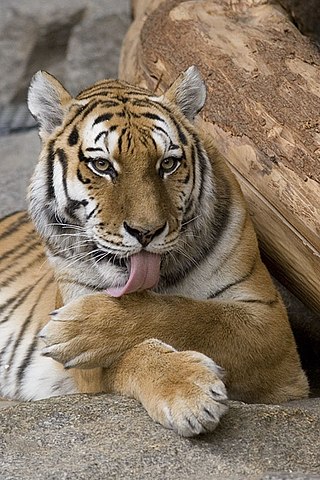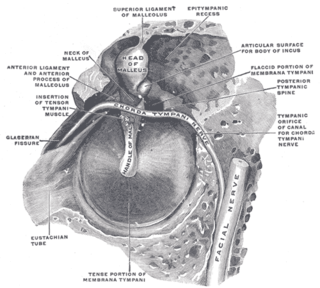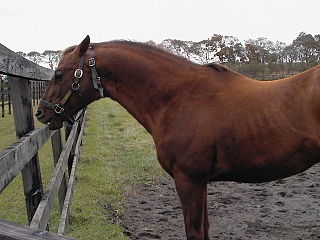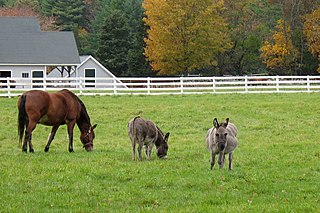
Horse teeth refers to the dentition of equine species, including horses and donkeys. Equines are both heterodontous and diphyodontous, which means that they have teeth in more than one shape, and have two successive sets of teeth, the deciduous and permanent sets.

The tongue is a muscular organ in the mouth of a typical tetrapod. It manipulates food for chewing and swallowing as part of the digestive process, and is the primary organ of taste. The tongue's upper surface (dorsum) is covered by taste buds housed in numerous lingual papillae. It is sensitive and kept moist by saliva and is richly supplied with nerves and blood vessels. The tongue also serves as a natural means of cleaning the teeth. A major function of the tongue is the enabling of speech in humans and vocalization in other animals.

Licking is the action of passing the tongue over a surface, typically either to deposit saliva onto the surface, or to collect liquid, food or minerals onto the tongue for ingestion, or to communicate with other animals. Many animals both groom themselves, eat or drink by licking.
A stereotypy is a repetitive or ritualistic movement, posture, or utterance. Stereotypies may be simple movements such as body rocking, or complex, such as self-caressing, crossing and uncrossing of legs, and marching in place. They are found especially in people with autism spectrum disorders, visually impaired children, and are also found in intellectual disabilities, tardive dyskinesia and stereotypic movement disorder, yet may also be encountered in neurotypical individuals as well. Studies have shown stereotypies to be associated with some types of schizophrenia. Frontotemporal dementia is also a common neurological cause of repetitive behaviors and stereotypies. A number of causes have been hypothesized for stereotypy, and several treatment options are available.

Chorda tympani is a branch of the facial nerve that carries gustatory (taste) sensory innervation from the front of the tongue and parasympathetic (secretomotor) innervation to the submandibular and sublingual salivary glands.

Flunixin is a nonsteroidal anti-inflammatory drug (NSAID), analgesic, and antipyretic used in horses, cattle and pigs. It is often formulated as the meglumine salt. In the United States, it is regulated by the U.S. Food and Drug Administration (FDA), and may only be lawfully distributed by order of a licensed veterinarian. There are many trade names for the product.

Cribbing is a form of stereotypy, otherwise known as wind sucking or crib-biting. Cribbing is considered to be an abnormal, compulsive behavior seen in some horses, and is often labelled a stable vice. The major factors that cause cribbing include stress, stable management, genetic and gastrointestinal irritability.

A tongue-tie is a piece of equipment used by equestrians to prevent a horse from getting its tongue over the bit, which would make the animal very difficult to control. It is usually a strip of cloth or rubber, passed through the mouth and tied below the chin.

Stable vices are stereotypies of equines, especially horses. They are usually undesirable habits that often develop as a result of being confined in a stable with boredom, hunger, isolation, excess energy, or insufficient exercise. They present a management issue, not only leading to facility damage from chewing, kicking, and repetitive motion, but also leading to health consequences for the animal if not addressed. They also raise animal welfare concerns.
Lameness is an abnormal gait or stance of an animal that is the result of dysfunction of the locomotor system. In the horse, it is most commonly caused by pain, but can be due to neurologic or mechanical dysfunction. Lameness is a common veterinary problem in racehorses, sport horses, and pleasure horses. It is one of the most costly health problems for the equine industry, both monetarily for the cost of diagnosis and treatment, and for the cost of time off resulting in loss-of-use.

The gustatory nucleus is the rostral part of the solitary nucleus located in the medulla. The gustatory nucleus is associated with the sense of taste and has two sections, the rostral and lateral regions. A close association between the gustatory nucleus and visceral information exists for this function in the gustatory system, assisting in homeostasis - via the identification of food that might be possibly poisonous or harmful for the body. There are many gustatory nuclei in the brain stem. Each of these nuclei corresponds to three cranial nerves, the facial nerve (VII), the glossopharyngeal nerve (IX), and the vagus nerve (X) and GABA is the primary inhibitory neurotransmitter involved in its functionality. All visceral afferents in the vagus and glossopharyngeal nerves first arrive in the nucleus of the solitary tract and information from the gustatory system can then be relayed to the thalamus and cortex.
The primary gustatory cortex (GC) is a brain structure responsible for the perception of taste. It consists of two substructures: the anterior insula on the insular lobe and the frontal operculum on the inferior frontal gyrus of the frontal lobe. Because of its composition the primary gustatory cortex is sometimes referred to in literature as the AI/FO(Anterior Insula/Frontal Operculum). By using extracellular unit recording techniques, scientists have elucidated that neurons in the AI/FO respond to sweetness, saltiness, bitterness, and sourness, and they code the intensity of the taste stimulus.

Guttural pouches are large, auditory-tube diverticula that contain between 300 and 600 ml of air. They are present in odd-toed mammals, some bats, hyraxes, and the American forest mouse. They are paired bilaterally just below the ears, behind the skull and connect to the nasopharynx.

Lingual papillae are small structures on the upper surface of the tongue that give it its characteristic rough texture. The four types of papillae on the human tongue have different structures and are accordingly classified as circumvallate, fungiform, filiform, and foliate. All except the filiform papillae are associated with taste buds.

Lignophagia is the abnormal behaviour of chewing and eating wood. It has been recorded in several species, but perhaps most commonly in horses where it is usually called, simply, "wood chewing". Lignophagia is a form of the pica disorder, in which normally non-nutritive substances are chewed or eaten. For some animals, wood is the normal primary food source; such animals are known as being xylophagous.
Equine gastric ulcer syndrome (EGUS) is a common cause of colic and decreased performance in horses. Horses form ulcers in the mucosa of the stomach, leading to pain, decreased appetite, weight loss, and behavioral changes. Treatment generally involves reducing acid production of the stomach and dietary management. Unlike some animals, however, stomach rupture is rare, and the main goal of treating is to reduce pain and improve performance of animals used for showing or racing.
Neonatal maladjustment syndrome (NMS) is a syndrome where newborn foals exhibit uncommon behaviors, occurring in three to five percent of live births. These behaviors can include aimless wandering, hypersensitivity to loud sounds and brightness, weakness or coordination issues, and the incapability to nurse. Neonatal maladjustment syndrome is often referred to as dummy foal syndrome by the equine community due to the aimlessness of the foals, nicknaming them "wanderers" or "dummy foals".

The horse body mass is highly variable, depending on breed, model, physiological state, condition, owner's purpose and usage of the animal. Always 65 % to 75 % water, it is divided on average between 50 % muscle, 11 % bone and 10 % fat. Depending on whether it's a pony or a draft horse, it can range from less than 200 kg to over a ton, with an average of 500 kg for saddle horses. It also differs with the season, as horses are almost always fatter in summer than in winter. Various tools are used to estimate their weight and body condition, and veterinary scales have been created to determine whether a horse has an ideal body mass according to precise criteria. Thinness is associated with mistreatment, but owner-independent factors such as age and illness can cause dramatic weight loss in horses. In Western countries, equine obesity is one of the major veterinary health problems of the 21st century. It is directly linked to numerous pathologies, such as laminitis, osteoarthritis, insulin resistance and colic. It also favors the development of equine Cushing's disease, and causes a drop in stallion fertility.

Horse pain caused by the bit refers to the various painful sensations of varying intensity and duration that horses may experience from the use of a bit during riding, due to poor adaptation of the equipment to their morphology or excessive stress. These pains are frequently associated with oral lesions, particularly in the corners of the mouth, interdental spaces, premolars and tongue. Rarely visible from the outside, for example through hemorrhage, these lesions receive little attention. Pain and lesions are accompanied by fear and anxiety in the animal. They potentially concern all horses wearing a bit manipulated by a human being via reins, whether mounted or harnessed, in particular by the application of great tension in these reins.






















